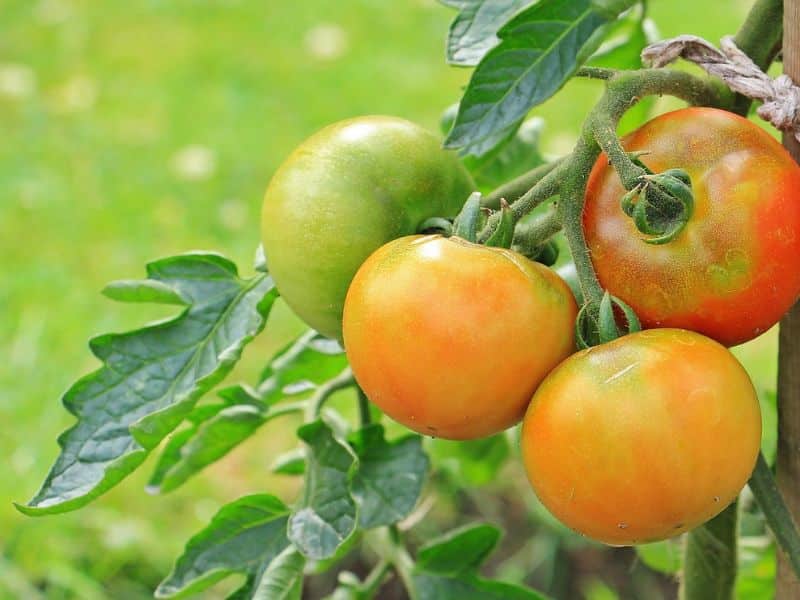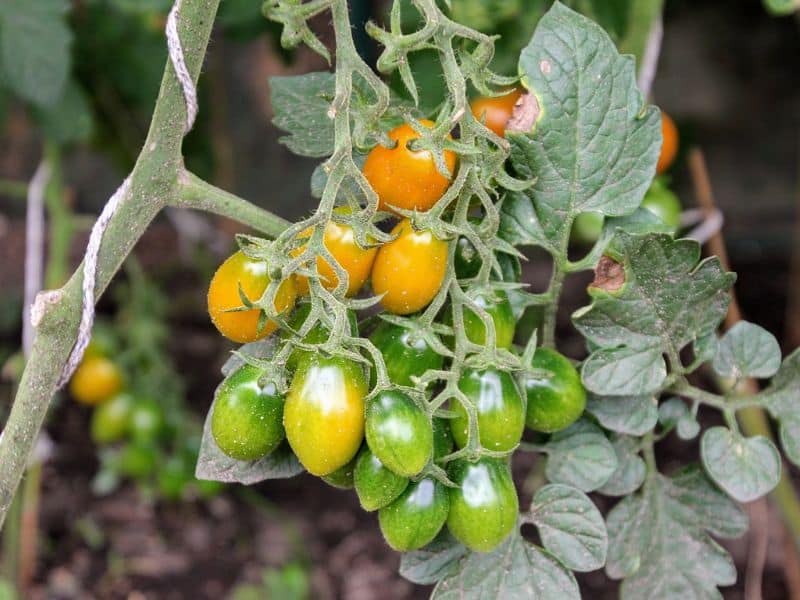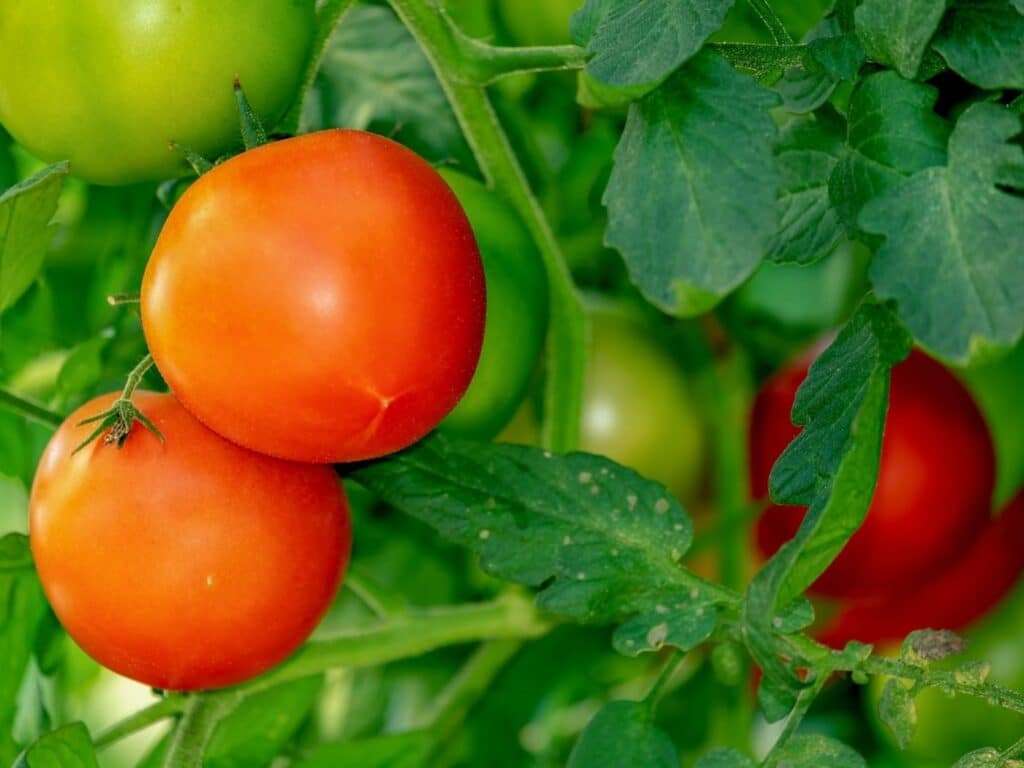As you stroll through your garden, the sight of yellowing leaves on your tomato plants can halt you in your tracks. This common issue perplexes many gardeners, from novices to the more experienced.
It’s not just a matter of aesthetics; yellow leaves can signal underlying problems that, if left unchecked, may impact your plant’s health and tomato yield. Understanding the causes of this discoloration is the first step toward nurturing your plants back to their vibrant green glory.
Fortunately, identifying and addressing the reasons behind the yellowing leaves can often be straightforward. Whether it’s due to nutritional deficiencies, improper watering, or disease, there’s usually a solution at hand.
This article aims to arm you with the knowledge to diagnose and remedy the issue, ensuring your tomato plants remain as healthy and productive as possible. Let’s dive into the world of tomato cultivation and uncover how to keep those leaves green and flourishing.
Understanding Why Tomato Plant Leaves Turn Yellow
Yellowing leaves on your tomato plants can stump even the most experienced gardeners. Let’s dive into the reasons behind this pesky problem and figure out how to turn things around.
Nutrient Deficiencies
Yellow leaves often scream “Feed me!” because they’re indeed hungry – but not for just anything. Nitrogen, potassium, and magnesium top the list of nutrients your tomatoes are possibly lacking.
Without them, chlorophyll can’t do its green-making magic, leading to those yellow tones. Think of it as your plant telling you, “I need a balanced diet.” A well-timed dose of balanced fertilizer can save the day, transforming your plants back to lush, vibrant health.
Watering Issues
Too much love in the form of water can actually drown your tomato plants’ roots, leading to an overwatered tomato plant, while too little leaves them thirsty and stressed. Both scenarios can trigger leaf yellowing as a distress signal.
The trick is to find that Goldilocks zone – not too much, not too little, but just right. Regular, even watering, allowing the soil to slightly dry between watering sessions, strikes the perfect balance. Your plants will thank you with deep green leaves.
Environmental Stress
Last but certainly not least, environmental stressors play a big role. Temperature swings, too much direct sun, or not enough light can cause your tomato plants to throw a yellow flag of caution.
It’s like your plant saying, “I’m not comfortable!” Adapting your care routine to provide shade during the hottest part of the day or protecting them from chilly nights can help stabilize their environment. Remember, a happy plant is a green plant.
Common Diseases That Cause Yellowing

Yellow leaves on your tomato plants can signal issues beyond just watering and nutrition. Getting to grips with the diseases that lead to this symptom can guide you in keeping your plants healthy. Let’s dive into some common culprits.
Fusarium and Verticillium Wilt
Fusarium and Verticillium wilt are fungal foes that sneak into your tomato plant’s system through the roots. Once inside, they clog up the plant’s internal water transport system. This blockage leaves leaves yellow, wilted, and often leads to the death of the plant if not caught early.
The difference? Fusarium usually hits one side of the plant first, while Verticillium tends to be a bit more democratic, spreading its yellowing more evenly. Combat these dastardly diseases by opting for resistant plant varieties and practicing crop rotation.
Early Blight and Septoria Leaf Spot
Early blight and Septoria leaf spot are like the two troublemakers in class, causing yellow spots and dropping leaves faster than you can say “tomato.” Early blight brings dark, concentric rings on older leaves, looking like a target.
Meanwhile, Septoria leaf spot prefers to sprinkle tiny, black dots inside the yellow areas, as if it’s creating a starry night on your tomato leaves. Keep these pests at bay with well-spaced plants for good air circulation and avoid watering from above to keep leaves dry.
Tomato Mosaic Virus
The Tomato Mosaic Virus (ToMV) takes the cake for being a sneaky saboteur. It’s not picky; leaves, fruit, and stems can all show symptoms ranging from mottling and discoloration to downright distortion.
Think of it like giving your tomatoes a bad case of the mottles. Unfortunately, there’s no cure once a plant is infected. Prevention is your best friend here—sanitize your garden tools and keep an eye on those hands after handling cigarettes or infected plants, as tobacco can transmit ToMV.
By understanding these diseases and taking proactive measures, you can help your tomato plants avoid the dreaded yellow leaf syndrome. Always remember, healthy plants start with keen observation and timely action.
Pest Infestation and Its Impact on Leaves
Aphids and Whiteflies
Aphids and whiteflies are common culprits behind the yellowing leaves of tomato plants. These tiny pests suck the sap from the leaves, depriving them of vital nutrients. Hence, leaves turn yellow, wilt, and may eventually fall off.
Additionally, these pests excrete a sticky substance known as honeydew, which can lead to the growth of sooty mold on the leaves. Controlling these pests involves a combination of regularly inspecting plants, introducing natural predators like ladybugs, and if necessary, using insecticidal soaps.
Spider Mites
Spider mites, though tiny, can have a colossal impact on tomato plants. These pests thrive in hot, dry conditions, and their feeding results in yellow, speckled leaves, severely weakening the plant. To combat spider mites, maintain consistent moisture levels around your plants, and consider misting the leaves in dry weather.
For severe infestations, miticides may be applied, though non-chemical interventions are preferred to safeguard beneficial insects. Regular monitoring for these pests, especially during warm, dry periods, is crucial for maintaining plant health.
Cultural Practices to Prevent Yellowing

Addressing the root causes of yellowing leaves on tomato plants begins with adopting healthy cultural practices. Proper attention to spacing, watering, and fertilization can significantly reduce the risk.
Proper Plant Spacing
Giving your tomato plants plenty of room to breathe works wonders. Ideal spacing avoids overcrowding, ensuring each plant gets enough light and air. This reduces humidity around the plants, cutting down on the risk of fungal infections that can lead to yellow leaves. Aim for about 24 to 36 inches apart for most varieties. Remember, a cramped tomato is an unhappy tomato.
Adequate Watering Techniques
Watering your tomatoes correctly is a bit of an art form. They need a consistent moisture level, not too wet and not too dry. Aim for about 1 to 2 inches of water per week, but feel free to adjust based on weather conditions.
Always water at the base to keep leaves dry and reduce the chance of disease. A mulch layer can help maintain soil moisture and temperature, keeping those roots happy.
Regular Fertilization Schedule
Tomatoes are hungry plants, but too much of a good thing can lead to problems. An imbalanced diet causes yellow leaves, among other issues. Use a balanced fertilizer that provides all the necessary nutrients in the right amounts.
Apply it every 4 to 6 weeks during the growing season to promote healthy, vibrant foliage. But hey, don’t go overboard with it; you’re feeding a tomato plant, not a teenage boy.
Advanced Solutions
Use of Fungicides
To combat fungal infections causing yellow leaves, consider applying fungicides. However, it’s crucial to identify the exact pathogen affecting your tomato plants. Fungicides work effectively against diseases like Early Blight and Septoria Leaf Spot but choose the right product for your problem.
Always read and follow the label instructions carefully for the best outcomes. Application timing and frequency play significant roles in fungicide effectiveness, so keep a vigilant eye on weather conditions and disease progress.
Introducing Beneficial Insects
Inviting beneficial insects into your garden acts as a natural defense against pests contributing to yellow leaves. Ladybugs and lacewings, for example, feed on aphids and whiteflies, reducing their numbers and the stress they cause your plants. You can attract these helpful allies by planting flowers like marigolds and cosmos around your tomato garden.
Maintaining a diverse ecosystem not only aids in pest control but also enhances the overall health of your garden. This approach takes patience but offers a rewarding, environmentally friendly way to keep your tomato plants thriving and their leaves green.
When to Seek Professional Help
If your tomato plants’ leaves continue turning yellow despite your best efforts, it may well be time to call in the experts. Situations that resist home remedies, like persistent diseases or severe pest infestations, require professional assessment.
Consulting a plant pathologist or an experienced horticulturist becomes critical if you’re facing ongoing issues. They’ll offer specialized advice, pinpointing the exact cause and suggesting specific treatments to revive your tomato plants. Remember, catching problems early can save your garden, so don’t hesitate to reach out if things look grim.
Frequently Asked Questions
Why are my tomato plant leaves turning yellow?
Yellowing leaves on tomato plants can result from nutrient deficiencies, diseases such as Fusarium wilt and Early Blight, and pest infestations like aphids and spider mites. Proper nutrition and care are vital for prevention.
How can I prevent diseases in my tomato plants?
Preventing diseases in tomato plants involves practicing crop rotation, maintaining soil health, and ensuring balanced nutrition. Applying fungicides can help manage fungal infections. Early intervention is crucial to prevent disease spread.
What should I do if my tomato plants have pests?
If your tomato plants have pests like aphids and spider mites, introducing beneficial insects such as ladybugs can help. In severe cases, using appropriate insecticides may be necessary. Always follow label directions to avoid plant damage.
Can professional help save my yellowing tomato plants?
Yes, seeking professional help can be crucial if yellowing persists despite home remedies. A plant pathologist or horticulturist can offer specialized advice and treatments, especially for persistent diseases or severe pest infestations. Early expert intervention can save your garden from extensive damage.
Up next:







